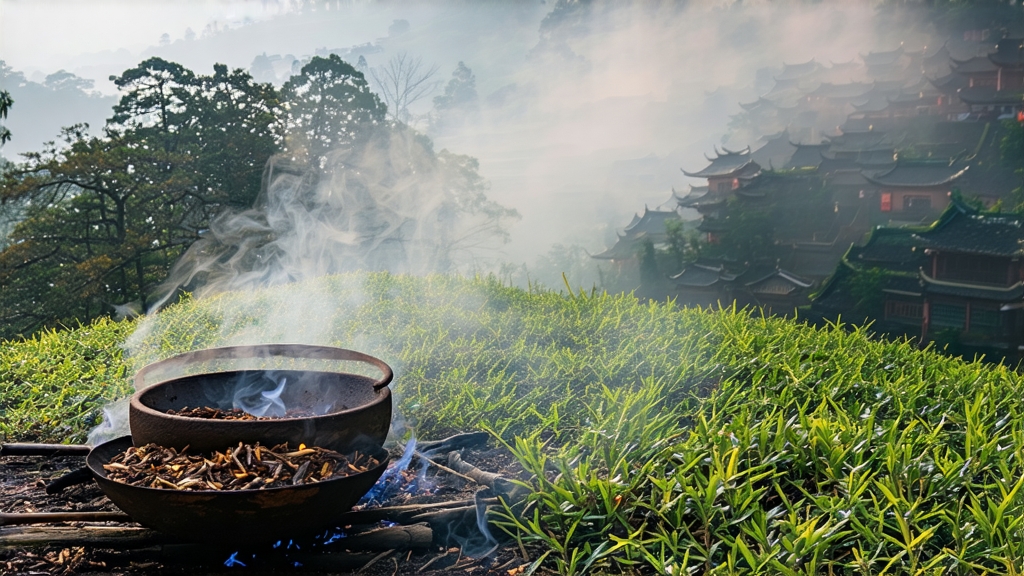
Long before Assam, Ceylon, or Earl Grey entered the lexicon of tea drinkers, there was Lapsang Souchong—the original black tea that startled the courts of Europe in the early seventeenth century and re-defined what “tea” could taste like. Nestled in the Wuyi Mountains of northern Fujian, where granite cliffs trap humid mists and camphor-scented forests shade the soil, Lapsang Souchong (literally “small plant from the original mountain”) emerged as both accident and artistry. Local lore claims that during the late Ming dynasty, passing armies forced tea farmers to rush the drying process; pine torches thrown into the withering shed imparted a resinous perfume that proved irresistible to the Dutch traders waiting on the coast. Whether myth or marketing, the story captures the tea’s defining paradox: a delicate leaf transformed by bold smoke.
Although today the term “Lapsang” is slapped on everything from cocktails to lip balm, authentic Zheng Shan Xiao Zhong—the protected-origin name—can only be produced within the 600–1,200 m micro-climate of Tongmu Guan, a village so remote that visitors must surrender smartphones at the checkpoint to prevent GPS mapping of its rare seed-stock gardens. Here, two distinct styles coexist. The traditional “smoked” version, exported since 1604, is withered over embers of local Masson pine, rolled briefly to bruise the leaf edges, oxidized until the coppery aroma of stewed apples rises, then fired in bamboo baskets suspended above slow-burning resin-rich logs. The result is a glossy, midnight-brown strip that smells like a campfire wrapped in leather. Since 2005, a “unsmoked” or “craft” variant has gained favor among Chinese connoisseurs who prize the honeyed minerality of the original leaf; it is withered on bamboo trays above charcoal braziers, oxidized in cloth-lined wooden boxes, and baked at 80 °C three separate times to coax out notes of longan fruit and wet stone without a whisper of smoke. Both styles share the same cultivar—Xiao Ye Zhong, a small-leaf landrace that has acclimated to the region’s cool fog and iron-rich laterite soil.
The smoking process itself is less brute force than aromatic choreography. Pine wood is split into finger-thick slivers, stacked to dry for six months until the sap crystallizes, then fed into a pit oven whose temperature must hover between 60–70 °C; hotter and the leaf chars, cooler and the resins condense into an acrid film. Master smokers judge the fire by ear: a steady crackle means the lignin is releasing its bouquet of borneol and terpenes, while a hiss signals sap that will sour the cup. Every twenty minutes they toss the leaves with long-handled rattan forks, ensuring each bud absorbs only a gauze of smoke rather than a tarry cloak. A single lapse in rhythm can ruin a night’s work; Tongmu farmers still quote the aphorism “one eye on the flame, one eye on the moon,” because clear skies often coincide with dropping humidity that can over-dry the leaf.
To brew Lapsang Souchong respectfully, treat it like a peated whisky: water that is too hot bullies the subtlety, while timid water leaves the drama veiled. For the smoked style, use 3 g of leaf per 120 ml vessel—ideally a thin-walled porcelain gaiwan or a tall glass teapot that showcases the liquor’s translucent carnelian glow. Rinse the leaf for three seconds to awaken the oils, then infuse at 90 °C for five seconds, adding one second for each subsequent steep. The first pour delivers a burst of pine and wintergreen that quickly yields to caramelized sugar and baked plum; by the third infusion the smoke recedes like distant thunder, exposing a core of cocoa and dried persimmon. The unsmoked version prefers 85 °C and longer steeps: start at fifteen seconds and you will be rewarded with a golden cup that smells of lychee and wet slate, finishing on a cooling note reminiscent of Wuyi mineral springs. Both styles forgive at least six infusions, a generosity rare among black teas.
Professional cupping follows a Fujian protocol designed to separate true Tongmu leaf from the fumigated imposters common in export markets. Five grams are placed in a 150 ml white porcelain tasting set, flash-infused with boiling water for five minutes. The liquor of authentic